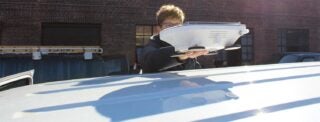- Resources
- Tech innovators should pay attention to NYC’s new air pollution monitoring pilot
Resources
Tech innovators should pay attention to NYC’s new air pollution monitoring pilot
Published: January 21, 2020 by Harold Rickenbacker
New York City operates over 30,000 City-owned vehicles, the largest municipal fleet in the country. Police cars, fire engines, and public buses drive up and down the city streets performing their public services duties. But what if while completing their routine routes, doing their regular jobs, these vehicles were doubling as mobile air pollution monitoring networks?
Today, the New York City’s Mayor’s Office announced CityScanner, a new pilot program that will use city fleet vehicles to measure local air quality. Municipal vehicles mounted with state-of-the-art sensors developed by the Massachusetts Institute of Technology (MIT) will collect hyperlocal data as they drive around the Bronx. This pilot will help determine the tremendous potential that innovative technologies hold for improving our understanding of air pollution.

Manager, Clean Air & Innovation
“We’re very excited about the possibilities of this pilot to help gather additional insights about hyper-local environmental conditions in New York City. In previous mobile sensing pilot projects, EDF’s experience has helped other cities gather similar insights. We look forward to working with them with an eye towards improving quality of life for all residents,” said Paul Rothman, Director, Smart Cities + IoT Lab with the Mayor’s Office of the Chief Technology Officer.
NYC’s pilot is the latest example of how municipalities are prioritizing air pollution in unprecedented ways. This momentum is in part due to technological advancements that are revolutionizing the ability to measure air pollution at the neighborhood scale.
But to keep up with growing demands for sensor technologies and advanced analytics, we need more investment and innovation in this space.
The growing air pollution monitoring market
Air pollution is extremely localized, making cities uniquely situated to lead clean air strategies. In fact, cities are generating a “race to the top” in tackling air pollution, demanding that the world’s largest urban areas take action today.
The first step in tackling air pollution is to fully understand it – or as we say, make the invisible, visible. Many cities have conventional air pollution monitoring systems with sensors spaced miles apart from one another, and some have no systems at all. This sparse monitoring can result in large data gaps – for example, air pollution can be up to 8 times worse on one end of a city block than another.

Today, lower-cost sensors can provide incredibly detailed insights about specific facilities, roads or neighborhoods and how air quality may change at those locations over the course of a day, week or year. Cities are using these block-by-block insights to drive tailored, local solutions that protect our health and environment, as we’ve seen in London, Oakland, Houston and more recently in Denver.
To better understand and identify sources of air pollution, Denver, launched a citywide air quality monitoring network “Love My Air” funded by the Bloomberg Mayors Challenge. The Department of Public Health and Environment installed outdoor PM2.5– a respiratory particle linked to premature death from heart and lung disease– monitors at 21 public schools in Denver to test pollution levels at or near schools.
The system transmits the pollution data directly into an IoT network, lowering overall cost of data communication, which is then shared with school officials and parents in real-time through a user-friendly interface. The new insights provided by these technologies helped motivate urgency that prompted the city to devise and implement powerful new interventions to improve the health of students and families. For example, the City is encouraging and investing in clean modes of transportation and adjusting outdoor physical activities during school hours based on Air Quality Indices.
Denver also sees economic opportunity. More than $3,000 in medical cost is spent per student per year on asthma in the Denver public school system. Based on this, the City estimates it could save nearly $30 million per year by simply supporting clean air projects that help curb pollution levels.
Technology providers can play a role in local monitoring efforts
The market for lower-cost sensors and instruments is expected to grow as hyperlocal air pollution monitoring – like we’re seeing in NYC and Denver – gains popularity, representing a big opportunity for tech innovators.
Air pollutants have different physical properties, as well as different health impacts, which have implications for how best to measure and map them. Customers will require and select a monitoring instrument that is appropriate for their specific air pollution needs and goals – the pollutants that need to be measured and the data quality needed for monitoring objectives.
As more technologies enter the market, tech innovators should become familiar with key performance indicators and data management processes to understand what role they should play at each step. This will enable companies to work with municipalities to develop monitoring instruments that are appropriate for their specific needs.
By working together, cities and tech innovators can develop solutions at scale that bring us one step closer to cleaner, safer air.
Follow Harold on Twitter
Follow EDF+Business on Twitter
